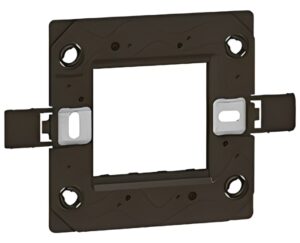What Is a Legrand 1 Gang Frame and Why Choose It?
A Legrand 1 Gang Frame is the mounting surround that holds a single switch or socket module in place. It defines the visible edge, protects the wall opening, and delivers a precise fit that looks professional. Because it is part of a modular system, it helps installers configure circuits fast while maintaining consistent style across rooms and panels.
Where does a 1 gang frame fit in modern installations?
In residential projects, it typically houses a light switch or a single power outlet. In offices and labs, it can carry data or AV points next to laptops, controllers, or test equipment. In light industrial zones, it may host a key switch tied to sensors or access hardware for equipment with microcontrollers and microprocessors.
Benefits that matter to specifiers and installers
A frame seems simple, yet it influences safety, durability, and long term maintenance. The right frame avoids gaps, improves ingress protection, and keeps fingerprints or oils off the wall surface during use. It also aligns with matching faceplates, so a building’s switches, LEDs, and outlets share one design language.
Practical benefits at a glance
-
Streamlined appearance that hides rough wall edges and aligns with sockets or switches.
-
Stable mounting that resists over tightening and maintains true alignment over time.
-
Material and finish options that handle thermal variation and daily wear.
-
Compatible with modules for data, power, and control in electronics projects.
Key selection criteria
Choosing the correct Legrand 1 Gang Frame starts with the environment, then the module type. Consider finish, color, ingress resistance, and compatibility with cables and back boxes.
Environment and durability
Busy corridors, workshops, and classrooms see frequent hand contact. Select finishes that resist scuffs and support cleaning without discoloration. In warmer spaces, a frame with good thermal stability reduces warping and keeps the module seated. Where dust is present, pair the frame with gaskets and sealed modules to limit contamination around connectors and contactors.
Compatibility with modules
Legrand’s modular approach lets you combine the frame with a variety of inserts. Common modules include rocker switches, USB chargers, and data keystones. For labs or benches, you may use specialty modules with capacitors, status LEDs, or small controllers. Always confirm that the frame depth and clipping system match the module family.
Back box and cable routing
A neat result depends on a solid back box. Ensure stud, masonry, or surface boxes are true and flush. Check that the frame offsets leave space for cable bend radii, especially when working with stiff data cables or thicker conductors that feed fuses, switches, and power modules.
Installation guidance for a professional finish
Good technique is as important as good hardware. The following steps help deliver a precise, repeatable result.
Prepare the opening
-
Verify the back box is square, secured, and aligned with the wall surface.
-
Inspect cables for sheath damage, then dress conductors with gentle grips to avoid nicks.
-
Pre fit the module in the frame to confirm clearances before final tightening.
Mount and align
-
Seat the frame carefully to avoid trapping wires behind the module.
-
Tighten evenly using insulated tools to protect coatings and edges.
-
Wipe fingerprints or residual oils with a soft cloth to preserve finish integrity.
Test and label
-
Function test switches and indicator LEDs after wiring.
-
Label circuits clearly, especially where controllers, sensors, or microcontrollers are involved.
-
Capture photos for documentation, which speeds future maintenance.
Style, materials, and finishes
Design choices affect both perception and hygiene. Smooth surfaces clean quickly and resist buildup. Matte or satin finishes reduce glare in areas with task lighting. Frames with subtle chamfers guide the eye and sit flush, which helps in architectural spaces where detail lines matter. Color matching with adjacent faceplates and nearby electronics improves visual cohesion across the board.
Safety and compliance considerations
Safety starts with correct pairing of frame, module, and back box. Follow local wiring rules and torque guidance. In areas with frequent cleaning, ensure material compatibility with cleaning agents. Where electrostatic concerns exist, consider modules that include ESD protective features and keep sensitive connectors away from high energy circuits that feed contactors or larger controllers.
Working with smart and low voltage modules
Modern fitouts often mix mains power with low voltage control. A Legrand 1 Gang Frame can host data or control modules for building systems that include sensors, occupancy monitoring, or small logic boards. Keep segregation of low voltage and mains where required. Use proper ferrules on terminations, and route cables to minimize crosstalk near microprocessors or high switching currents.
Thermal and environmental notes
Thermal shifts can loosen fasteners or distort poor quality frames. Choose frames rated for the expected temperature band, especially near heat sources or under strong lighting. When modules dissipate heat, add airflow or use thermal pads and correct backing to maintain performance. Protect outdoor or damp locations with sealed accessories and consider UV stable finishes.
Maintenance and lifecycle
A well installed frame should last for years with simple cleaning. Periodically check that screws are snug and the frame remains flush. If a module fails, the frame makes maintenance easier because you can swap the insert without replastering or repainting. Keep spares of high use modules and verify that replacement parts maintain the same fit and color.
Use cases across sectors
-
Residential lighting, including dimmers and energy monitoring displays.
-
Office power and data outlets near desks with laptops and docking stations.
-
Education labs with indicator LEDs, low voltage switches, and test connectors.
-
Light industrial stations with e stop circuits, discrete sensors, and small controllers.
Troubleshooting common issues
Misalignment usually traces back to a twisted back box or uneven wall surface. Correct with shims or repair the opening. Wobble indicates over tightened screws or a module not fully seated in the frame. Discoloration can follow exposure to harsh cleaners, so match cleaning products to the specified finish.
Procurement checklist
-
Confirm exact module family and mechanical interface.
-
Match color and finish across adjacent frames.
-
Verify environmental ratings for dust or moisture.
-
Plan cable routing and space for bends behind the module.
-
Prepare labels for circuits and data identification before handover.
Final thoughts
A Legrand 1 Gang Frame is a small part that has outsized impact on appearance, safety, and serviceability. With the right selection and careful installation, it supports reliable power and data delivery for years, from simple lighting to electronics control points that touch sensors, connectors, and smart building modules.






